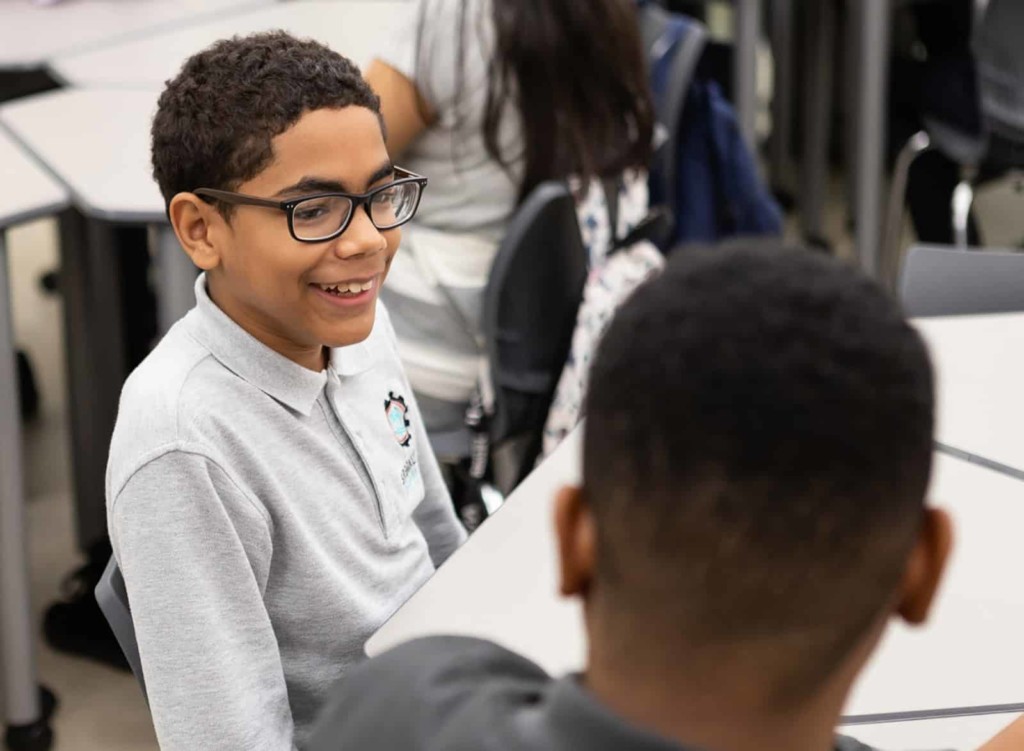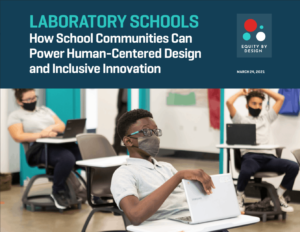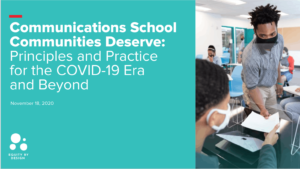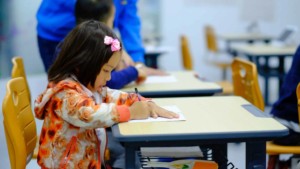To Reopen, America Needs Laboratory Schools

As COVID-19 ravages vulnerable communities and threatens a resurgence later this year, educators are finding meaning in the ingenuity and servant leadership of our peers. Since schools have closed, communities around the country have developed creative solutions for remote learning, engagement, and support.
As the summer nears and we start to think about the possibility of schools reopening in the fall, we have so much to take stock of, from enacting public health guidelines, to handling the social-emotional impacts on our communities, to rebuilding strong operational and financial foundations.
But even as we all make plans to respond to the pandemic, we have a once-in-a-lifetime chance to reimagine and improve our school operating systems. Opening our doors will open new opportunities for thinking deeply about how we support all students to thrive and learn. Stacey Childress, CEO of NewSchools Venture Fund, calls this education’s “Apollo 13 moment”: Safeguarding our school systems for re-entry can feel a bit like getting back to Earth with a mismatched box of tools. “We need teachers and system leaders to generate bold solutions and tools to address the challenges presented by the many possible futures we could see later this year,” Childress says.
Kim Smith, executive director of the League of Innovative Schools at Digital Promise, says districts are already pioneering forward-thinking approaches to reopening. “They are working to design solutions on shared priorities, and teachers and administrators are partnering with families, students, entrepreneurs, and researchers to design and refine options for the fall,” she says.
As schools open, educators will be faced with unprecedented complexity, from new logistical challenges to emergent needs for the most vulnerable students.
No school has the time, resources, and bench strength to tackle all of these challenges alone. But there are schools that currently serve as laboratories pioneering innovative approaches to education on a daily basis. Now is the time for the nation’s laboratory schools to band together to design the solutions and practical tools all schools will need for an effective return.
Those embracing the ‘laboratory school’ role (i.e. in this case, the role of serving as a laboratory for the generation of innovative solutions that promote equitable re-entry) would benefit from learner-centric methodologies that help examine problems of practice faced and give educators an opportunity to pilot potential solutions. By engaging the school community, as well as a diverse group of experts, the laboratory schools approach can help educators receive and apply wide-ranging insights to make the preparation process inclusive and equitable and to create and pilot solutions rapidly.
Seven Ways Lab Schools Can Design and Lead an Equitable Reopening
Just as the public health system has mobilized its R&D infrastructure to combat COVID-19, laboratory schools have a chance to use their innovation networks to help our nation to rise to the challenge of reopening schools. In the absence of certainty about when and how schools will reopen, educators need to prepare for the possibility that the coronavirus will follow the pattern set by the 1918 Spanish flu. The University of Minnesota’s Center for Infectious Disease Research and Policy warns that with no vaccine or herd immunity, a second, larger wave of COVID-19 could appear this fall or winter.
Schools need to communicate and prepare for the possibility of periodic resurgences that could continue over the next couple years. We must develop strategies, including reinstituting mitigation measures, to ensure the protection of educators, students, and families when the disease surges.
“Ensuring that reopening prioritizes equity is an obligation. Schools need the flexibility to do what is necessary to ensure that all students from all backgrounds can fully benefit from educational opportunities this fall,” observes Michele Cahill, the senior advisor to the XQ Institute. “As I speak with principals and teachers across the country as they draft and begin to implement reopening plans, they are listening to what students and families are experiencing, as well as what they need and want going forward. Equitable reopening entails having honest conversations with each other, collecting and analyzing data, formulating creative solutions, and listening to what others are learning along the way.”
Just as health systems use the concept of triage to focus on what’s most important and act quickly and effectively, laboratory schools can focus on seven domains to develop effective solutions that could be used more widely as part of our nation’s re-entry planning.
1. Community Engagement and Communication
The best solutions will arise if we engage and solicit feedback from students, families and teachers in planning our re-entry strategies.
“It is vital to understand in context how students, families, educators, and instructional leaders experience potential approaches to reopening,” says Dr. Temple Lovelace, an associate professor of special education at Duquesne University. “Limiting harm for students and families represents a prime directive. Building and rebuilding respectful and trusting relationships across the school community is imperative as we prepare for re-entry.”
Students, in particular, must have a voice, says Trace Pickering, the executive director of Iowa BIG in Cedar Rapids. Students and their families are the ones who will experience any practical complications with particular approaches to re-entry, and since these experiences won’t be the same for all students, it’s important to take an inclusive approach to engaging them. “By involving communities of color in early-stage problem articulation and solution design, we are more likely to forge an equitable path forward,” says Jonathan Flynn, head of family and community engagement at Brooklyn LAB.
Taking this approach will also build trust in the process within the school community and will enhance the legitimacy of reopening planning processes. “Promising practices and novel solutions for equitable re-entry will emerge from planning processes that sensitize us to the lived experiences, constraints, priorities, and insights of the learners, families, and communities most impacted by COVID-19,” says Jennifer Charlot, partner at Transcend.
2. Academics and Unfinished Learning
Schools can use insights from the learning sciences to address unfinished learning in reopening plans.
Most students will return to school with unfinished learning from the prior year or even years. “Educators will understandably struggle to address both accumulated unfinished learning and grade-level standards and will need systemic innovations that go beyond the work of getting back to school,” says Chris Rush, the chief program officer at NewClassrooms.
To forestall the “COVID-19 slide,” schools can apply evidence-based insights on “learner variability.” “It’s critical that schools ground plans for the fall in the needs of individual students, rather than the fiction of an average student,” says Vic Vuchic, executive director of the Learner Variability Project (LVP) at Digital Promise. “LVP can help planning by providing practitioners and learners with more effective learning strategies and supporting the design of more effective supports.”
3. Brick and Mortar and Online Learning
Given the uncertainty of a COVID-19 resurgence, schools must prepare for staggered schedules, medical fragility, and a permanent online learning option for the next 18 to 24 months (even if that online option is never utilized).
“Given the range of scenarios education systems are preparing for, schools could be standing up brick and mortar as well as virtual academic programs, to be prepared to transition seamlessly between the two as realities change, “says Jimmy Sarakatsannis, partner at McKinsey & Company. “This could also involve creating tailored programs that cater differentially to medically fragile populations, special education students, and vulnerable students who are less able to learn remotely”.
Doing this right will take partnerships. “Schools should investigate moving structures to competency-based education systems that empower learners,” says Susan Patrick, president and CEO of the Aurora Institute. “Activating student agency and ownership and personalized learning plans are critical foundations needed to scale anytime, anywhere learning to larger numbers of students, including complex learners, allowing shifts to happen more quickly for a limited time.” Patrick recommends using learning continuity readiness assessments and testing them before they are needed.
Schools must build flexible academic systems that can accommodate such transitions. “We started as an online school and then added brick and mortar campuses,” says Laurie Wolfe, chief academic officer of Gem Prep Schools. “As we prepare for the fall, we are refining our common pictures of instructional excellence for both physical and online learning.”
4. Whole Child and Transition Focus
Especially during a public health crisis, it’s important to attend to all student needs, including health, academic, social-emotional, and even financial needs.
“Transition, uncertainty, and loss can make the most vulnerable students discouraged and disengaged,” says Gabrielle Schlichtmann, executive director and chief scientist at EdTogether. Through the Educating All Learners Alliance, we have seen how complex learners can be affected by their environment, and we believe it’s critical to share information so all educators can incorporate approaches to meet the needs of diverse learners in their school settings.
This may take collaboration with health and social services institutions and other organizations. “Schools need a holistic approach,” says Meredith Liu, the co-founder and chief design officer of The Primary School, which integrates academics with health care and family support services. “A student with a loved one who is ill, has lost a job, or is grieving will need more than just academic supports. Schools must help parents navigate their own financial, educational, and wellness challenges.”
It will also mean asking students themselves about their needs. “How can we meet students wherever they are?” asks Erin Whalen, the founding assistant principal at Da Vinci RISE, which serves students who have become disconnected from traditional school systems “How can we use flexibility and support to help students reclaim their own learning process and instill them with renewed confidence?”
5. Data and Privacy
Managing re-entry demands tracking data for key safeguards for infrastructure, transportation, food service, scheduling, staffing, and health and behavioral norms. Data must be used to inform re-enrollment, remediation, and resurgence planning. “COVID-19 demands new, cross-functional metrics to assess effectiveness for learning, health, and childcare,” says Erin Slezak, deputy chief of the strategy of KIPP Texas Public Schools, “This will demand greater alignment and clarity about how we measure performance.”
Marcos Alcozer, program director for the Data Viz Starter Pack at InnovateEDU, suggests developing certain essential reopening-focused reports now: “Prepare a suite of reports to manage re-entry in all key areas: academics, assessment, attendance, demographics, safety, and discipline,” he says. “Secure architecture and best data practices are an integral piece of any reopening plan.”
As schools work to design an academic program capable of toggling between onsite and offsite, it’s critical to take an inventory of current educational technology applications and how they operate together. For example, schools can make the student experience for logging in more seamless by conquering single sign through services like Clever or ClassLink or integrating applications to your Google Suite. By focusing on this element of student experience, schools can eliminate a set of user-driven issues, ensure that login is safe and secure through permissions management, and enhance system interoperability with shared identification credentials.
6. School Safety and Purpose
Every school is built on a foundation of providing a safe space for all students to learn. As schools reopen, educators should reflect on safety and purpose: How are you creating that safe space so that all students can thrive? What is the purpose of your school, in terms of the students you serve and how you serve them?
“Schools need a foundation of relational safety and trust so that individuals can thrive and grow,” says Daren Dickson, chief culture officer of Valor Collegiate. “As we prepare to come back together physically, we need to be intentional about our plans to develop this relational web of support so that students can feel safe and known and can begin to re-engage in their learning in holistic and meaningful ways.”
It’s a good time to double down on purpose, whether that’s promoting learning through experiential projects, ensuring equitable education, or educating every student to understand the world is their classroom.
At New Harmony High in Louisiana, the focus is on project-based learning. “Our high school focuses on coastal restoration and preservation,” says Sunny Dawn Summers, founding school leader. “Our students will help create a sustainable Louisiana through project- and problem-based learning, with community members serving as mentors for students to experience relevant mission-driven fellowships.”
Latitude High School in Oakland, California, also engages the community and encourages students to learn inside and outside the walls of the school. “Oakland is one of the most dynamic and diverse places on Earth,” says principal Lillian Hsu. “We have a proud history of activism, arts, and grassroots collaboration. The pandemic adds new urgency to our vision of the city as our home and the Bay Area as our classroom. We must create a sense of community, purpose, and belonging for our students.”
Every school has a chance to cultivate wonder, curiosity, and eagerness for learning, says Heather Graham, the director of the Oak Foundation’s Learning Differences Programme. “Plans should aim to unlock the creativity and power of every young person and equip each one to shape a more just and equitable response to COVID-19,” she says.
7. School Operations
The core school operating systems—from procurement and contracting, to data and IT, to human resources and stakeholder engagement—define what that school can do. In the pandemic, all of these operations must be applied, says Steven Hodas, former executive director, Office of Innovation, New York City Department of Education. “The OS often determines the support available to teachers, students, and families,” he adds. “There’s still time to open this fall with new OS components in place.”
Aaron Daly, COO of Brooklyn LAB, says each department should be thinking about their role in solutions to some key challenges: “How can we best engage and respect students and families in the process of preparing to reopen? How can we best embed designers, trauma expertise, learning scientists, and technical-assistance providers into the planning process? How can we improve the quality of reopening plans by engaging educators and instructional leaders in our preparation?”
Look to Laboratory Schools for Working Examples
For the next six months, our nation’s education sector should focus on articulating problems of practice in school communities, and on generating and modifying tools and solutions for practice-related challenges faced by learners and educators during re-entry. Laboratory schools are well-positioned to showcase real examples of different aspects of reopening.
As leaders of one such laboratory school, we are committed to spending considerable time and effort this summer and fall to codify and share both pain points and best practices with peers. At Brooklyn LAB, we hope to do our part to research and share solutions that can power our shared national response to this pandemic.
“We are excited about the opportunity to positively impact the field beyond our school campuses,” says Brooklyn LAB CFO Sheryl Gomez. “We hope to do this alongside laboratory schools around the country.”
The compassion and hard work of teachers and leading educators position pioneering schools to help our country to build a bridge to a more equitable future.
For more, see:
- How to Reopen Schools: A 10-Point Plan Putting Equity at the Center
- Hard Reset: What Will Be New Post Pandemic
- Educating All Learners During COVID-19: An Alliance Emerges to Provide Support for Virtual Special Education Services
- We can rise to the challenge of educating students with disabilities during COVID-19
- During the COVID-19 pandemic, how do we ensure that learning moves forward for all learners, especially students with disabilities?
- Teacher2Teacher educator resources for equity and inclusion
Stay in-the-know with innovations in learning by signing up for the weekly Smart Update.
Getting Smart has launched the Getting Through series to support educators, leaders, and families on the path forward during such an uncertain time. This series will provide resources and inspiration as we face long term school closures, new learning environments, and address equity and access from a new lens. Whether you are just getting started with distance or online learning, or you’ve had plans in place and have the opportunity to share your work and guidance with others, there is a place for your voice and an opportunity to learn.
We’re going to get through this together, and we invite you to join us. Please email [email protected] with any questions or content you’d like considered for publication. We also invite you to join the conversation and on social media using #GettingThrough.






0 Comments
Leave a Comment
Your email address will not be published. All fields are required.